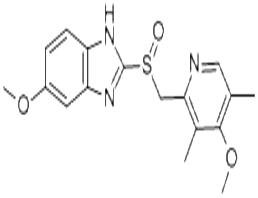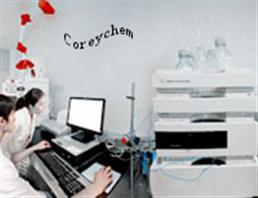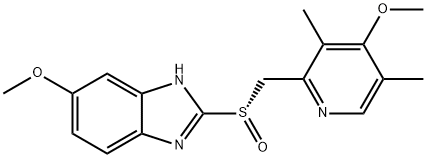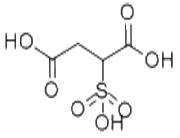| General Description |
Esomeprazole (English brand name: Inexium), is the S-isomer of omeprazole. In 1990, in vitro gastric gland model confirmed that two isomers of omeprazole have the same proton pump inhibitory effect. However, it was not possible at that time to prepare a sufficient number of individual isomers for in vivo testing, and the isolated isomers could be slowly racemized in aqueous solution. When sufficient amounts of both isoforms were available for human tesing, the effect of the oral S-isomer was proved to be about 4 times better than that of the R-isomer. Esomeprazole decreases the amount of acid produced in the stomach through specific targeting. It is weakly alkaline and works as a specific inhibitor of proton pumps in parietal cells. Also it concentrates and transforms into an active form in the acid environment of the parietal oxynticus microtubules, thus inhibiting H / K-ATPase (proton pump) of this body part and inhibiting the the secretion of basic gastric acid and stimulated gastric acid. Its curative effects for gastroesophageal reflux disease are better than omeprazole in terms of symptoms relief, inhibition of gastric acid produced in the stomach and promoting the improvement of esophagitis. |
| Indication |
- Gastroesophageal reflux disease (GERD) is when food or liquid travels from the stomach back up into the esophagus, often causing heartburn, acid reflux, retrosternal pain and other symptoms, and also causing pathologic damage to esophageal mucosa. GERD is one of the common clinical acid-related diseases, and the key to treat the gastroesophageal reflux disease is to inhibit gastric acid secretion. Esomeprazole (eaomeprazole) is the laevo isomer of omeprazole (Nexium), used to treat eflux esophagitis with quick effect and good acid suppression. It can be used alone or in combination with Prokinetic agent or gastrointestinal mucosal protective agent,and its curative effect is better than other PPI (esomeprazole, lansoprazole, omeprazole, pantoprazole, rabeprazole),Also it’s safe and effective for the elderly and children infected with reflux esophagitis.
- Erosive reflux esophagitis treatment
- Long-term maintenance for healed esophagitis patients.
- To control symptoms of gastroesophageal reflux disease (GERD) and combine with appropriate antimicrobial therapy to eradicate ofHelicobacter pylori
- To heal the Helicobacter pylori-related duodenal ulcer
- To prevent the Helicobacter pylori -related peptic ulcer recurrence.
|
| Usage and Dosage |
Swallow the tablet together with the liquid. Don’t chew or crush.
- Gastroesophageal Reflux Disease (GERD)
1. Erosive reflux esophagitis treatment: 40mg once a day.
Duration of therapy: four weeks.
2. An additional 4 weeks may be considered for patients with esophagitis not healed or the symptoms don’t resolve after initial treatment. Long-term maintenance for healed esophagitis patients: 20mg once a day.
3. Gastroesophageal reflux disease (GERD) symptom control
Patients without esophagitis: 20mg once a day. If symptoms are not controlled after 4 weeks, further examinations should be done to the patient. Once the symptoms have been resolved, 20 mg orally once a day should be taken to maintain the symptom resolution and healing.
4. Combine with appropriate antibiotic therapy to eradicate Helicobacter pylori, heal the Helicobacter pylori-related duodenal ulcer and prevent the Helicobacter pylori -related peptic ulcer recurrence.
Triple therapy: esomeprazole 20 mg + amoxillin 1 g + clarithromycin 500mg, twice a day. Duration of therapy: 7 days. |
| Side effects |
- None of the following side effects have been found dose-related.
- Common side effects (> 1/100, <1/10): headache, stomach pain, diarrhea, bloating, nausea / vomiting, constipation.
- Rare side effects (> 1/1000, <1/100): dermatitis, itching, hives, dizziness, dry mouth.
- The following side effects have been observed in the use of racemaic modification (omeprazole), and therefore they may also occur during the use of esomeprazole.
|
| Definition |
ChEBI: A 5-methoxy-2-{[(4-methoxy-3,5-dimethylpyridin-2-yl)methyl]sulfinyl}-1H-benzimidazole that has S configuration at the sulfur atom. An inhibitor of gastric acid secretion, it is used (generally as its sodium or magnesium alt) for the treatment of gastro-oesophageal reflux disease, dyspepsia, peptic ulcer disease, and Zollinger-Ellison syndrome. |

 China
China










